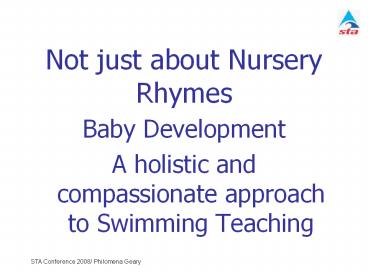Not just about Nursery Rhymes - PowerPoint PPT Presentation
1 / 24
Title:
Not just about Nursery Rhymes
Description:
18 months have same neural connections as an adult. 6 year olds have four times ... In our enthusiasm to eradicate SIDS in the 0.2% of infants who are potential ... – PowerPoint PPT presentation
Number of Views:136
Avg rating:3.0/5.0
Title: Not just about Nursery Rhymes
1
Not just about Nursery Rhymes
- Baby Development
- A holistic and compassionate approach to Swimming
Teaching
2
Balanced!!!
- First 3 years vital
- Experiences child exposed to
- 18 months have same neural connections as an
adult - 6 year olds have four times greater
- Brain spring clean at adolescence
3
The Brain
HIGHER BRAIN
Postural Reflexes
LIMBIC (Emotional Brain)
Primitive Reflexes
REPTILIAN BRAIN
4
Primitive Reflexes
- Survival
- Stereotypical
- Sequential
- Inhibited during 1st year
- May be retained
- May re-occur
5
Retained Primitive Reflexes
- Some remain throughout life Blinking
- Absence may indicate damage to CNS
- C Section Babies
- Brain Injury Cerebral Palsy
- Stroke may cause re-occurrence
- Degenerative disease Multiple Sclerosis
6
Spinal Development
STA Conference 2008
7
Pros Cons of Back to Sleep
- Decrease in SIDS?
- Reluctance for tummy time
- Increase in Plagiocephaly
- Development delay
8
In our enthusiasm to eradicate SIDS in the 0.2
of infants who are potential victims, we have
tended to overlook other relative risks and
benefits of the supine vs the prone position in
the 99.8 of infants who will not succumb to
SIDS.Doman G, Doman J, (2006), How Smart is
Your Baby, 249
9
Tonic Labyrinthine Reflex(TLR)
- Head to Toe development
- Basis for gaining control of neck muscles
- Some TLR control by 6 weeks
- Inhibition can lead to postural problems
10
Spinal Galant
- Birthing Reflex
- Gradual inhibition over first 9 months
- Retention can cause fidgeting Ants in the
Pants
11
Asymmetrical Tonic Neck Reflex(ATNR)
- Works in conjunction with Spinal Galant
- Allows for breathing (on tummy)
- Facilitates early reaching
- Retention can lead to difficulties crossing
mid-line plus swimming - frontcrawl
12
Symmetrical Tonic Neck Reflex(STNR)
- Bridging Reflex
- Allows Opposite Movements between Top Bottom
- Develops Sight
- Precedes Creeping
- Difficulty with copying from board
- Difficulty with forward rolls and breastroke
13
Palmer Reflex
- Grasp reflex
- 11 weeks in utero
- Inhibited by 2-3 months
- Replaced by pincer grasp
- Retained inability to oppose fingers
- Lack of Fine Motor Skills
14
Moro Reflex
- 9-12 weeks in Utero
- Reaction to sudden imbalance or frightening
stimulus - Fight or Flight
- Replaced by Adult Startle Reflex
15
Inhibition of the Startle Reflex
- Pulling back of the head
- Habituation
- Primacy
- Think of the journey not the end result!
16
Songs Rhymes
- Helps to develop
- Language
- Attention
- Orientation
- Sound Discrimination
- Memory
17
Are You in Your Right Mind?
18
Singing Babies
- Melody recognition Right Hemisphere
- Vocabulary storing Left Hemisphere
- Parentese
- Essential for development of reading
- Sounding Out
19
LET YOUR HEART
- RULE YOUR HEAD
20
- The affairs of the heart are directly connected
to the brain and its the hearts natural
intelligence that must be unfolded for the brain
to operate with greater efficiency. - Chilton Pearce J, (1994), Evolutions End
21
Heart Intelligence
- Being in Heart
- Connections between the Heart Limbic Centre
- Frontal Lobe Emotional Intelligence
- Conditioning Reptilian Brain
- Compassion Emotional Brain
22
- .the three-year-old is not an incomplete
five-year-old, but a complete, total and whole
three year old. If a child is given all the
nurturing to be here as a three year old theyll
be the perfect five year old later on, and so
on. - Joseph Chilton Pearce
23
Teach with Compassion
- Teaching with
- FUN
- SUNSHINE
- LOVE
24
Sources of Information
- Chamley C et al, (2005), Developmental Anatomy
Physiology of Children - Chilton Pearce J, (1992), Evolutions End
- Doman G, Doman J, (2006), How Smart is Your Baby
- Goddard Blythe S, (2004), The Well Balanced Child
- Institute for Neuro-Physiological Psychology,
www.inpp.org.uk































